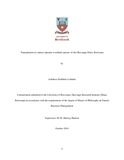Please use this identifier to cite or link to this item:
http://hdl.handle.net/10311/1419Full metadata record
| DC Field | Value | Language |
|---|---|---|
| dc.contributor.author | Lubinda, Aobakwe K. | - |
| dc.date.accessioned | 2015-12-08T12:49:32Z | - |
| dc.date.available | 2015-12-08T12:49:32Z | - |
| dc.date.issued | 2015-12-08 | - |
| dc.identifier.uri | http://hdl.handle.net/10311/1419 | - |
| dc.description | A dissertation submitted to the University of Botswana, Okavango Research Institute in accordance with the requirements of the Master of Philosophy in Natural Resource Management Citation: Lubinda, Aobakwe K. (2014) Transpiration in various riparian woodland species of the Okavango Delta, Botswana, University of Botswana Supervisor: Dr M. Murray-Hudson | en_US |
| dc.description.abstract | In arid and semi-arid areas, evapotranspiration (ET) by phreatophytes is a principal groundwater sink and a significant component of wetland water budgets. Understanding and accurately quantifying ET is necessary for water resources management, especially under an uncertain climatic future. In the Okavango Delta ET consumes about 96% of the total input, mainly from islands which are fringed by riparian woodlands. ET measurements, however, have historically been difficult to make and hence ET tends to have been calculated as the remainder term from the water balance. Using the compensation heat pulse velocity method, sap flow measurements, which are widely used in ecophysiological field studies, were used in this study to estimate tree transpiration in the distal, mid and upper Delta during low, medium and high water levels. These were related to air temperature, relative humidity and soil moisture and groundwater levels. The relationship between sap flow and tree size was also explored. Transpiration for the whole Delta was estimated from sap flow measurements and ET from groundwater fluctuations. Sap flow varied between and within species in different seasons because of environmental factors and plant characteristics as seasons changed. High temperatures and low relative humidity led to increases in sap flow. Relationships between sap flow and soil moisture were unclear whilst groundwater significantly responded to sap flow, declining with increased sap flow and increasing when sap flow slowed down. ET from the whole Delta (with riparian woodland covering an area of 1.19E+09 m²) was estimated to be 4.06E+09 L/year from sap flow measurements. This is equivalent to 27% of the total annual input into the Delta. Groundwater fluctuations gave estimates of 8.47E+09 L/year (56%), almost double the sap flow estimates. | en_US |
| dc.language.iso | en | en_US |
| dc.subject | Sap flow | en_US |
| dc.subject | Compensation heat pulse velocity method | en_US |
| dc.subject | Transpiration | en_US |
| dc.title | Transpiration in various riparian woodland species of the Okavango Delta, Botswana | en_US |
| dc.type | Masters Thesis/Dissertation | en_US |
| dc.rights.holder | University of Botswana, http://www.ub.bw | en_US |
| Appears in Collections: | Masters Dissertations (ORI) | |
Files in This Item:
| File | Description | Size | Format | |
|---|---|---|---|---|
| Lubinda, AK final.pdf | 3.66 MB | Adobe PDF |  View/Open |
Items in DSpace are protected by copyright, with all rights reserved, unless otherwise indicated.
